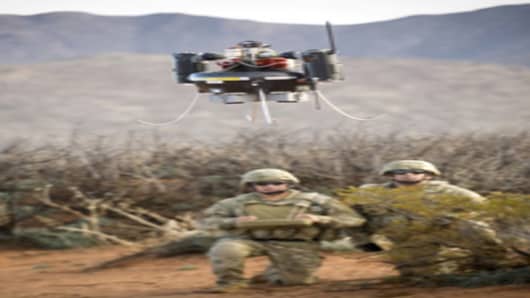The Army hatched a plan a decade ago for a new approach to fighting ground wars. Called Future Combat Systems, it was an ambitious project to develop networks of high-tech vehicles, drones and robotic sensors to act as frontline spies on enemy targets.
“We wanted to go deep and really stretch and see if we could come up with a new conceptual basis for the Army,” said Joe G. Taylor Jr., a retired Army major general who was involved in the early stages of the program.
But that future is unlikely to arrive.
The Obama administration began scaling back the program late last month and breaking it into pieces, as part of a broader effort to overhaul expensive weapons contracts and focus more on fighting insurgencies.
Like many systems, the Army effort came to be seen by top Pentagon officials as too geared for conventional war at a time when the military needs to rely more on troops on the ground, and to provide them with simpler equipment designed to withstand roadside bombs and other more rudimentary attacks.
The Obama administration’s ability to make such a broad shift in military priorities is being tested in Congress in the fight over whether to keep building the advanced F-22 fighter. President Obama has threatened to veto a bill nearing a vote in the Senate if it includes any money for the jet.
And the changes in the Future Combat program, which was expected to cost $160 billion, illustrate how the administration is already proceeding to reshape military spending.
Defense Secretary Robert M. Gates recently canceled the most expensive part of the program, the new combat vehicles that were to cost $87 billion, out of concern that they would not provide enough protection against simple roadside bombs that have killed soldiers in Iraq and Afghanistan.
Mr. Gates also ordered the Army to renegotiate an unusually lucrative deal for the Future Combat Systems’ prime contractor, Boeing , which was guaranteed a much higher base fee than most Pentagon contractors. Boeing and its partner, SAIC Inc., stood to earn $2 billion before they proved the system’s components worked together.
The rethinking of the Future Combat program, one of the Pentagon’s most expensive, reflects the increasing pressure on the Army to redirect resources from plans for conventional wars to the possibility of other long-running conflicts with insurgencies in the future.
More than any other service, the Army faces enormous budget strains. It recently hired 65,000 more soldiers and also needs to give battle-weary troops more time at home. That means it has far less money than the Navy or the Air Force to modernize its weapon systems.
“Gates is clearly preparing the Navy and the Air Force to take the lead in major wars, and he wants the Army to focus more on having the troops it needs to sustain these long campaigns against insurgents,” said James McAleese, a military consultant in McLean, Va.
The idea for the new combat systems arose after Saddam Hussein’s invasion of Kuwait in 1990 exposed a hole in the Army’s capabilities.
The United States flew in an infantry division to defend Saudi Arabia, but it had to send tanks by sea. So the Army wanted to create a middle option — special brigades with combat vehicles light enough to airlift. It also figured that the ability to detect enemies from greater distances would reduce the need for armor.
But to receive the intelligence from the drones, small robots and other sensors that could be used like scouts, the Army needed to create a streaming video and data network unlike any other, something akin to a cellphone system without the fixed transmission towers. And the eight different vehicles would require innovative hybrid-electric drives to power new radios that could transmit such vast amounts of data.
The vehicles would be built with lightweight composite armors and have the ability to fire projectiles to defuse incoming missiles.
But most of the technologies were still at an experimental stage. And skeptics inside the Army asked how a vehicle weighing just 19 tons could match the firepower of a 70-ton tank and keep the crew safe.
As insurgents began destroying equipment with rocket-propelled grenades in the current Iraq conflict, the military recognized that the new vehicles would need more armor. Their projected weight increased to 30 tons, making them less easy to transport and weakening the rationale for the project.


